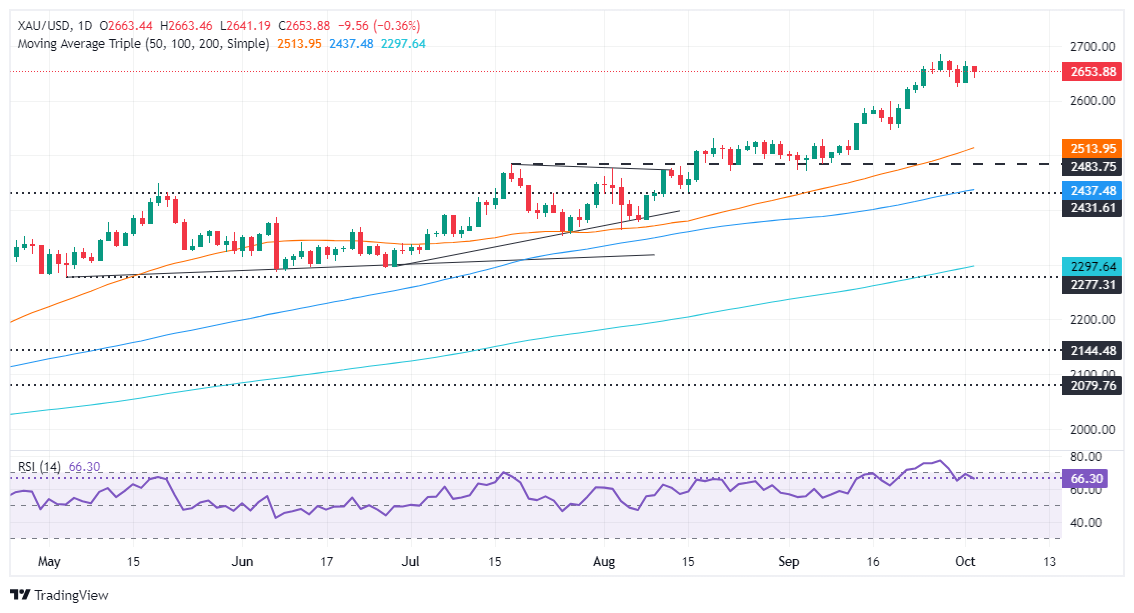Gold price drops on high US yields as Middle East conflict pauses
- Gold price slumps on Wednesday amid heightened tensions between Israel and Iran.
- A robust ADP National Employment Change report could be a prelude to an upbeat NFP.
- Nonfarm Payrolls data on Friday is expected to show 140K new US jobs in September.
Gold retreated on Wednesday during the North American session and dropped 0.50% daily as traders eyed Israel's reaction to Iran’s attack on Tuesday. Geopolitics remains the driver for traders, which lifted Gold prices after posting back-to-back bearish sessions since last Friday. At the time of writing, the XAU/USD trades at $2,648 after hitting a high of $2,663.
The market mood remains downbeat, as portrayed by US equities trading in the red. According to different newswires, developments in the Middle East suggest an escalation is likely. This indicates that Bullion prices could extend their gains in the short term.
Israel's envoy to the United Nations commented that Iran will face consequences for its missile attack on Tuesday. At the same time, US Deputy Secretary of State Kurt Campbell added that it is “not just Israel that is thinking about response options to Iran attack, US is too.”
In addition, private hiring in the United States (US) increased above estimates in September, according to ADP National Employment Change data. Meanwhile, Richmond Fed President Thomas Barkin said the 50-basis-point (bps) rate cut in September acknowledged that rates were “out of sync.”
Barkin added that some aspects of the economy suggest the disinflation process would continue but that "it remains difficult to say that the inflation battle has yet been won.”
The non-yielding metal added to gains after the Fed decided to lower the fed funds rate at the September meeting. Nevertheless, higher US Treasury yields and a stronger US Dollar during the day are headwinds for the precious metal.
The US 10-year Treasury note yields 3.783%, up five basis points. At the same time, the US Dollar Index (DXY), which tracks the buck’s performance against a basket of six peers, gains 0.39%, up at 101.60.
Ahead of the week, investors are tracking further US jobs data. On Friday, Nonfarm Payrolls figures are expected to show the economy added 140K people to the workforce in September, less than the 142K jobs created in August, while the unemployment rate is foreseen remaining unchanged.
Daily digest market movers: Gold price retreats amid Mideast war
- The ADP National Employment Change for September came in at 143K, up from the upwardly revised 103K the previous month and surpassing forecasts of 120K.
- August Job Openings & Labor Turnover Survey (JOLTS) improved, exceeding estimates and tempering woes of the labor market.
- Nevertheless, business activity in the manufacturing sector measured by the ISM Manufacturing PMI for September remained steady at 47.2, unchanged from the previous reading, but fell short of estimates of 47.5.
- Market participants have placed the odds of a 25 bps Fed rate cut at 63.8%, while the chances for a larger 50 bps cut have diminished to 36.2%, according to the CME FedWatch Tool.
XAU/USD technical analysis: Gold price creeps lower but stays above $2,650
Gold price is upwardly biased despite losing some steam as traders book profits, awaiting the next phase of the conflict. Momentum remains bullish as depicted by the Relative Strength Index (RSI) but is exiting from overbought conditions, sparking the retracement.
If XAU/USD drops below $2,650, this would open the door to test the September 30 daily low of $2,624, followed by the September 18 peak at $2,600. A breach of the latter will expose the 50-day Simple Moving Average (SMA) at $2,513.
On further strength, if it clears the all-time high of $2,685, it could extend its gains to $2,700.

Gold FAQs
Gold has played a key role in human’s history as it has been widely used as a store of value and medium of exchange. Currently, apart from its shine and usage for jewelry, the precious metal is widely seen as a safe-haven asset, meaning that it is considered a good investment during turbulent times. Gold is also widely seen as a hedge against inflation and against depreciating currencies as it doesn’t rely on any specific issuer or government.
Central banks are the biggest Gold holders. In their aim to support their currencies in turbulent times, central banks tend to diversify their reserves and buy Gold to improve the perceived strength of the economy and the currency. High Gold reserves can be a source of trust for a country’s solvency. Central banks added 1,136 tonnes of Gold worth around $70 billion to their reserves in 2022, according to data from the World Gold Council. This is the highest yearly purchase since records began. Central banks from emerging economies such as China, India and Turkey are quickly increasing their Gold reserves.
Gold has an inverse correlation with the US Dollar and US Treasuries, which are both major reserve and safe-haven assets. When the Dollar depreciates, Gold tends to rise, enabling investors and central banks to diversify their assets in turbulent times. Gold is also inversely correlated with risk assets. A rally in the stock market tends to weaken Gold price, while sell-offs in riskier markets tend to favor the precious metal.
The price can move due to a wide range of factors. Geopolitical instability or fears of a deep recession can quickly make Gold price escalate due to its safe-haven status. As a yield-less asset, Gold tends to rise with lower interest rates, while higher cost of money usually weighs down on the yellow metal. Still, most moves depend on how the US Dollar (USD) behaves as the asset is priced in dollars (XAU/USD). A strong Dollar tends to keep the price of Gold controlled, whereas a weaker Dollar is likely to push Gold prices up.

